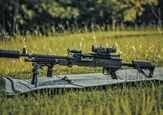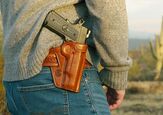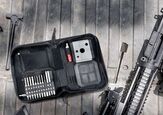(00)7 James Bond Guns You Didn’t Know About
This is a guest post from Caleb Daniels, author of the forthcoming book Licensed Troubleshooter: The Guns Of James Bond from Headstamp Publishing.
Fans of James Bond, and even people with just a cursory knowledge of the character, know about the Walther PPK, the P99, and maybe even Bond’s original Beretta .25 ACP. But throughout the 70 years of the literary James Bond and over 60 years of cinema, there have been so many other guns of 007. In my book, Licensed Troubleshooter - The Guns of James Bond, the most iconic small arms of the world’s most famous spy are covered in a coffee table book format from Headstamp Publishing (the team behind the legendary Vickers’ Guide series and other industry leading books). Our book is available for presale via Kickstarter now through October 11, 2024. In celebration of cinema’s best dressed action hero, this article will share (00)7 of my favorite lesser known Bond pistols.
#1 - Colt Police Positive
The Bond franchise begins not with the Walther PPK, or the Beretta .25 ACP, but a cut down Colt revolver, more specifically, a sawn barrel Colt Police Positive .38. In the first chapter of Casino Royale, the first James Bond novel published in 1953, we meet 007 for the first time. We also meet his cutdown Colt Police Positive. The chapter concludes with Bond leaving the casino floor, returning to his hotel room and going to sleep:
“His last action was to slip his right hand under the pillow until it rested under the butt of the ·38 Colt Police Positive with the sawn barrel. Then he slept, and with the warmth and humour of his eyes extinguished, his features relapsed into a taciturn mask, ironical, brutal, and cold.” - Casino Royale, Chapter 1 - The Secret Agent
Fleming would later pen a number of letters back and forth with fan and firearms enthusiast Geoffrey Boothroyd about the guns of Bond, these letters famously led to Fleming selecting the PPK as Bond’s new sidearm. Boothroyd, though, much preferred revolvers and made the case often. In one letter, he mentioned the 2/3rds “Fitz Special” style trigger guard. Fleming loved this idea, and said that Bond would certainly adopt it. Unfortunately this never happens in the later novels, but it is easy to imagine a classic Fitz Special in Bond’s hands in this sequence.
#2 - Heckler & Koch P7
“After some argument, mainly from Bond, the Armorer had agreed on Heckler & Koch’s P7, ‘squeeze cocking’ 9 mm automatic in preference to the rather cumbersome VP70, with its long “double-action” pull for each single shot. The weapon was lighter and more like his old beloved Walther PPK, now banned by the Security Services.” – Icebreaker, Chapter 6, “Silver vs Yellow”
In continuation author John Gardner’s third Bond novel, Icebreaker (1983), 007’s pistol has been updated to the iconic Heckler & Koch P7 pistol chambered for 9mm. Bond is required to update his choice of weapon due to a real-world PPK malfunction in the hands of the British Security Services, which in 1974 nearly resulted in the kidnapping of Princess Anne. Unsurprisingly, this led to a rapid retirement for Bond’s beloved pistol. The P7 was the third of four pistols that Gardner issued Bond before finally committing to a pistol. The biggest travesty in Icebreaker is that Bond never once fires his P7. None of the high-octane action sequences of the book lead to Bond dramatically battling his foes with this brilliant pistol; it instead finds itself sidelined in favor of Bond’s backup weapon, kept in his car, a Ruger .44 Magnum revolver.
#3 - ASP 9mm
The ASP was the final pistol selected by Gardner, and would be used quite often by Bond in the books, unlike the P7. The ASP is a true product of its time, with dubious marketing laced with fantastical claims and half truths masking the pistol in a mysterious aura. In reality, it is a hyper-modified Smith & Wesson Model 39 series pistol, designed at a time where compact 9mm pistols did not exist. Reportedly, over 200 unique modifications were made to each pistol, with a number of these design changes being patented by designer Paris Theodore. Theodore himself was wrapped in an enigma, and claimed to have been directed to design the ASP based on a CIA requisition. He also made many claims of being an assassin and agent of the CIA. He designed other weapons, including a clipboard for hostage negotiation teams that had a three round burst function. Little of his story can be confirmed, but Theodore did testify at the infamous Church committee hearings, and his company shuttered soon after.
The promise of the ASP was a pistol that recoiled roughly the same as a Walther PPK .22LR, chambered in 9mm, with the power of a .44 Magnum thanks to the Glaser Safety Slugs it was paired with. That’s not hyperbole - real advertisements from the 1980’s make such claims verbatim. It’s little wonder, with its dramatic and unique profile, questionable ties to espionage, and incredible marketing, that this icon of the Cold War era landed in Bond’s holster.
#4 - Smith & Wesson Centennial Airweight
“M’s voice was final. ‘And what about something bigger?’
‘There’s only one gun for that, sir,’ said Major Boothroyd stolidly. ‘Smith & Wesson Centennial Airweight. Revolver. .38 calibre. Hammerless, so it won’t catch in clothing. Overall length of six and a half inches and it only weighs thirteen ounces. To keep down the weight, the cylinder holds only five cartridges. But by the time they’re gone,’ Major Boothroyd allowed himself a wintry smile, ‘somebody’s been killed.’” - Dr. No, Chapter 2 “Choice of Weapons”
With his Walther PPK, James Bond is issued a Smith & Wesson Centennial Airweight as a replacement for his “Long-Barreled Colt .45” that typically remained in his car. Due to an error on Fleming’s part, the original pairing of a small carry pistol and larger companion was exchanged for two compact sidearms instead.
This mistake is the result of the letters between Boothroyd and Fleming previously noted. Boothroyd, a massive fan of the American firearm culture and writing scene in the 1950’s, was rather enamored with the Centennial Airweight due to favorable writings of men like Elmer Keith. It was the early Airweight, with its backstrap “lemon-squeezer” grip safety that Boothroyd desired 007 to carry. The gun would have been paired with a Berns-Martin Lightning Triple-Draw shoulder holster, a spring retention based rig that carries the revolver upside down under the arm or on the belt in a strong side or cross-draw location, thus, triple-draw. This holster like the Airweight was well loved by Keith and others, and did end up in Bond’s hands, but it was unfortunately incorrectly matched with the PPK. Boothroyd recommended a larger .357 Magnum revolver as the back-up gun as well.
Fleming rejected the Airweight as a carry gun for Bond. Based on his background in British Naval Intelligence during WWII, he was quite fond of suppressors, and felt that 007 needed an automatic pistol, in the event one was necessary. This led to Fleming’s PPK decision. He elected to keep the holster, and chose Boothroyd’s concealed carry choice as the large frame pistol. This error did not last long. In the novel Dr. No, Bond shoots all five rounds at the villain’s “dragon” (armored vehicle) and later, when cabling headquarters, noted that, “KINDLY INFORM ARMOURER SMITH AND WESSON INEFFECTIVE AGAINST FLAME-THROWER.” This novel is the only time the revolver is mentioned. Later novels find the Colt back in 007’s car.
#4 - FN M1910
Dr. No is a film laden with firearm errors. I say that lovingly, the first EON Productions film is a masterpiece, and part of its charm is the sheer number of firearms standing in for other guns, which happens to be every pistol in the movie. The Walther PPK has a series of pistols standing in for it - I discussed this in greater detail recently with Ian of Forgotten Weapons (and Headstamp Publishing) on his YouTube Channel.
One of the more interesting stand-ins is found in one of the most iconic scenes in the whole franchise - as Bond lies in another scene that is easily quoted from memory for so many – Bond in Ms. Taro’s bedroom, waiting quietly in the shadows for his would-be assassin (Professor Dent), playing solitaire with a cigarette nonchalantly hanging from the corner of his mouth and a silenced pistol at hand.
Professor Dent bursts into the room, unloading his own suppressed handgun into the dummy Bond had assembled from pillows under his bedsheets, and that is when Bond acts. With Dent disarmed, we have a bit of dialogue between the two, as Dent attempts to be inconspicuous as he uses a rug to drag his gun (which had been tossed aside) back to his hands, with Bond seemingly unaware. Dent launches into action like a coiled spring, grabbing his gun by the grip, silencer held oddly in his second hand, only to be met with a dull click as his gun’s hammer falls on a spent chamber, and Bond responds, with the cold, calculating tone that invokes Fleming’s vision of a blunt instrument with:
“That’s a Smith & Wesson, and you’ve had your six.”
With the brilliant line comes Bond’s ballistic retort as well, as he fires into Dent’s defeated and crumpled form. As he removes his silencer (clearly a prop as evidenced by the rough twist and quick jerk of the device), we get a tight shot not of his earlier-seen Walther PP (which was supposed to be a PPK) but a set of FN Browning grip panels and the clear profile of an FN Model 1910. It should also be mentioned that in another continuity error Dent is clearly firing a 1911 of some sort, not a Smith & Wesson, with a capacity of seven rounds.
#5 - Colt Model 1903 Pocket Hammerless
Yet another example of cinematic stand-ins brings the preferred sidearm of the OSS and SOE into the world of James Bond. In You Only Live Twice, during the incredible Kobe dock fight sequence, 007’s PPK miraculously transforms into another .32 ACP, the Colt Model 1903 Pocket Hammerless. On the whole, this gun is one that is on the short list for firearms that “should’ve” been Bond’s pistol aside from the original Beretta and the PPK, due to its prolific use in clandestine services in the Second World War. The SOE was fond of shoulder holsters as well, adding to the Bond flair. The famed OSS Jedburgh teams, comprised of highly trained, adventurous, and indomitable-spirited men from across the United States and Europe, also found the Colt Model 1903 to be a reliable back-up pistol to their .45 caliber Colt Model 1911 pistols and carried them in shoulder holsters as well. It is little wonder that Bond also had a proclivity for this method of carry.
#6 - SIG P210
Some of the most striking behind the scenes photography of 2008’s Quantum of Solace show Daniel Craig’s Bond in dark clothing in stark contrast to the desert, wielding a captured SIG P210 pistol. The handgun was recovered by Bond off of the dead General Medrano and was with him as he drove Dominic Greene into the middle of nowhere, interrogating him about Quantum along the way. It is thanks to these moments that we get such memorable photography of Bond with this sidearm in his hand. The gold-stylized pistol is a perfect weapon for a budding dictator like General Medrano, who like so many before him found an ornate pistol to be a requisite symbol of power.
The SIG P210 was adopted into the Swiss military service in late 1948 as the “P49”. The design for the pistol began in 1937, Charles Petter’s Model 1935A pistol design was purchased by SIG. Unfortunately, the war placed the pistol’s development on hold, but in 1947, SIG began working once more on the pistol. The handgun is a typical Browning-style pistol and was itself inspired by the 1911. Due to the low bore axis, inner slide rails, grip angle, and trigger, the P210 is still today regarded as one of the finest and most accurate service pistols ever produced.
Book Summary
Licensed Troubleshooter: The Guns Of James Bond is a celebration of the most fascinating small arms wielded by one of the world’s most acclaimed action heroes, 007. An in-depth analysis which spans the entire collection of Bond films and the novels that inspired them, including those authored by Ian Fleming and as well as those of the continuation authors. This visual history thoroughly examines the design and implementation of Bond’s tools, and of course, their impact on 007.
Beyond simply paying tribute to the fictional hero of James Bond, Licensed Troubleshooter shines a spotlight on the real-world operators employing the same firearms, featuring interviews with current and former military and intelligence personnel from agencies in the United Kingdom and the United States, including the CIA, MACV-SOG, U.S. Navy SEALs, DSS, and more. These interviews, combined with substantive historical research, provide the reader with a deeper understanding of the often incredible history of these firearms, including their use in combat and clandestine services. Be prepared to see Bond’s guns in a way you’ve never seen them before.
More by Caleb Daniels





























Comments
Join the conversation
Surprised the Walther P5 didn't get a mention in the article. Despite appearing in both 1983 movies, neither ever pointed out the new gun or showed it clearly on screen so most people don't realize he wasn't using a PPK anymore.
The P210 image was reused for the cover of the (not very good) PS3/360 game Blood Stone: 007, and the (actually decent) DS game Blood Stone: 007
How exactly does the P210 have a low bore-axis? It isn’t any lower than other hammer fired pistols from the time period. The same can be said about the CZ-75. Internal slide rails make the bore axis appear to be lower because the frame moves higher up on the slide but that’s about it.